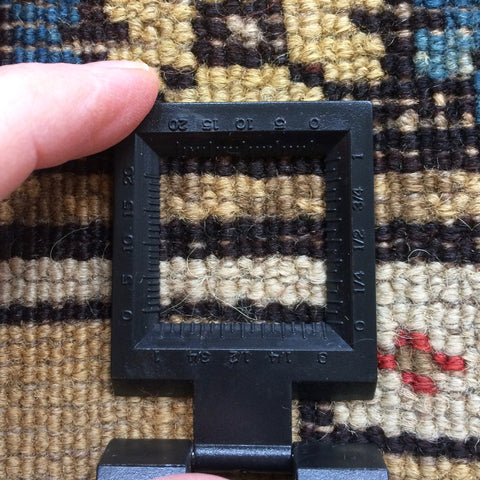Decoding the Knots: Understanding KPSI in Rugs
- Home
- Tabrizi Rugs Blog
- Decoding the Knots: Understanding KPSI in Rugs

KPSI: Understanding Rug Quality Through Knots Per Square Inch
When shopping for a handmade rug, you might come across the term “KPSI.” It’s an important factor in determining the quality and craftsmanship of a rug, but if you’ve never heard of it before, it can sound a bit technical. Don’t worry—understanding KPSI is much easier than you think, and it can make a world of difference when choosing the right rug for your space. Let’s break down what KPSI is, why it matters, and how it affects the look, feel, and durability of a handmade rug.


What is KPSI?
KPSI stands for Knots Per Square Inch. It refers to the number of knots that are woven into a single square inch of a rug. This measurement is an essential indicator of a rug’s quality, craftsmanship, and overall value. Simply put, the higher the KPSI, the more detailed and intricate the rug’s design can be.
When artisans create a handmade rug, they tie individual knots into the foundation, which is usually made of cotton, wool, or silk. These knots form the pattern and texture of the rug. Measuring the KPSI helps to quantify the density of these knots, allowing you to gauge the effort, time, and expertise that went into the rug’s production.
How is KPSI Measured?
To measure KPSI, you can count the knots within one inch of the rug’s width and height, then multiply the two numbers. For example, if a rug has 10 knots horizontally and 12 knots vertically in one square inch, the KPSI would be 120.
In some cases, sellers may provide KPSI as a general range rather than an exact number, especially for larger rugs. This is because the knot density can sometimes vary slightly across different sections of the rug due to the handmade nature of the process.
Why Does KPSI Matter?
KPSI gives you an insight into the level of detail in a rug’s design. The higher the KPSI, the more knots there are, allowing for finer details and more complex patterns. Lower KPSI rugs will typically have bolder, simpler designs because fewer knots limit the ability to include intricate details.
1. Durability
Higher KPSI rugs are usually more durable because they are densely woven. More knots mean a tighter weave, which can withstand foot traffic and last longer. This makes high-KPSI rugs an excellent choice for busy areas like living rooms, hallways, and entryways.
Lower KPSI rugs can still be durable but may be better suited for areas with lighter foot traffic. For example, they can be ideal for bedrooms or spaces where they’ll be more decorative than functional.
2. Detail and Intricacy
Rugs with a higher KPSI allow for more detailed and intricate designs. Think of it like pixels in a digital image—the more pixels, the clearer and more detailed the image will be. Similarly, the higher the KPSI, the more precise the patterns and motifs in a rug will appear.
On the other hand, lower KPSI rugs will have more geometric and abstract patterns. This isn’t necessarily a downside; in fact, many people love the boldness and simplicity of lower KPSI designs, especially when they’re seeking a more modern or minimalist look.
3. Time and Craftsmanship
A high-KPSI rug takes much longer to produce because each knot must be carefully tied by hand. It requires patience, skill, and expertise, particularly for more intricate designs. When you invest in a high-KPSI rug, you’re investing in the artisan’s time and mastery.
What is Considered a Good KPSI?
So, how many knots is “good”? It depends on what you’re looking for in a rug.
- Low KPSI (Less than 100 KPSI): Rugs with a KPSI of less than 100 tend to have simpler, more geometric designs. These rugs are often made with thicker yarn, giving them a more rustic and traditional feel. They can be perfect for spaces where you want a bold statement piece without too much detail.
- Medium KPSI (100 to 200 KPSI): Most high-quality rugs fall into this range. A KPSI of 100 to 200 allows for a balance between durability and design intricacy. These rugs are versatile and can feature a wide range of patterns, making them suitable for most spaces.
- High KPSI (200+ KPSI): Rugs with over 200 KPSI are considered to be finely woven. These are often made of silk or a combination of silk and wool, resulting in a luxurious, intricate design. High-KPSI rugs are highly sought after for their craftsmanship and artistry and are often considered investment pieces.
Does a Higher KPSI Always Mean a Better Rug?
While KPSI is an important factor, it’s not the only one to consider when choosing a rug. The material used, the skill of the artisan, and the overall design also play crucial roles in determining the rug’s quality and appeal. For instance, a well-made wool rug with a lower KPSI can be just as valuable and beautiful as a high-KPSI silk rug, depending on your taste and needs.
At Tabrizi Rugs, we believe that every rug tells a story, and KPSI is just one chapter. Whether you’re looking for a bold, geometric rug with a lower KPSI or an intricate, finely detailed piece with a high KPSI, understanding this measurement can help you make an informed decision.
Conclusion
KPSI might seem like a small detail, but it has a big impact on the look, feel, and longevity of your rug. When you’re shopping for a handmade rug, take a moment to consider the KPSI to ensure you’re getting the right balance of durability and design intricacy for your space. Whether you opt for a bold, simple design or a finely woven masterpiece, knowing a rug’s KPSI can help you appreciate the craftsmanship behind it.
So, next time you’re on the hunt for the perfect rug, you’ll be able to use KPSI to guide your choice, helping you find the perfect blend of style, quality, and craftsmanship.
Categories
Recent Posts

 CA ($CAD)
CA ($CAD) 